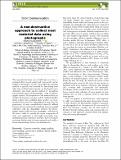A non-destructive approach to collect nest material data using photographs
Abstract
The materials that birds use to build their nests have a profound effect on nest quality and consequently on the builder’s reproductive success. Given that the common method to quantify nest materials by dismantling nests takes time and limits study species, we developed a non‐destructive and much quicker method for quantifying nest materials using nest photographs. Using our photographic method, the proportions of the main materials in 45 Blue Tit Cyanistes caeruleus and 20 Dartford Warbler Sylvia undata nests, including grass, heather, and moss, matched those found by dismantling the nests, while the proportions of rarer animal‐derived materials differed between the two methods. Provided that there is an initial calibration with the dismantling method, the photographic method offers the two key advantages: the reduction in time it takes to quantify the major components of nests, and the application to previously inaccessible data including museum collections. Together, these advantages encourage further study of nesting materials and enable a better understanding of avian nest diversification.
Citation
Sugasawa , S , Edwards , S C , Stanforth , R , Bruton , E , Hansell , M , Reilly , M & Healy , S D 2021 , ' A non-destructive approach to collect nest material data using photographs ' , Ibis , vol. Early View . https://doi.org/10.1111/ibi.12961
Publication
Ibis
Status
Peer reviewed
ISSN
0019-1019Type
Journal article
Description
Funding: Japan Society for the Promotion of Science (Grant Number(s): H28/1018); Biotechnology and Biological Sciences Research Council (Grant Number(s): BB/S01019X/1, EASTBIO scholarship).Collections
Items in the St Andrews Research Repository are protected by copyright, with all rights reserved, unless otherwise indicated.

